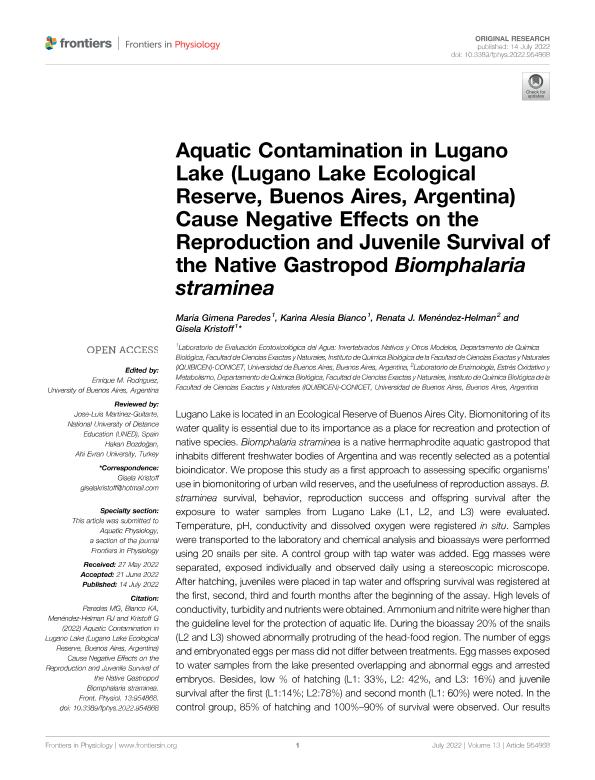Mostrar el registro sencillo del ítem
dc.contributor.author
Paredes, Maria Gimena

dc.contributor.author
Bianco, Karina

dc.contributor.author
Menendez Helman, Renata Julia

dc.contributor.author
Kristoff, Gisela

dc.date.available
2023-11-01T12:57:52Z
dc.date.issued
2022-07
dc.identifier.citation
Paredes, Maria Gimena; Bianco, Karina; Menendez Helman, Renata Julia; Kristoff, Gisela; Aquatic Contamination in Lugano Lake (Lugano Lake Ecological Reserve, Buenos Aires, Argentina) Cause Negative Effects on the Reproduction and Juvenile Survival of the Native Gastropod Biomphalaria straminea; Frontiers Media; Frontiers in Physiology; 13; 7-2022; 1-11
dc.identifier.issn
1664-042X
dc.identifier.uri
http://hdl.handle.net/11336/216737
dc.description.abstract
Lugano Lake is located in an Ecological Reserve of Buenos Aires City. Biomonitoring of its water quality is essential due to its importance as a place for recreation and protection of native species. Biomphalaria straminea is a native hermaphrodite aquatic gastropod that inhabits different freshwater bodies of Argentina and was recently selected as a potential bioindicator. We propose this study as a first approach to assessing specific organisms’ use in biomonitoring of urban wild reserves, and the usefulness of reproduction assays. B. straminea survival, behavior, reproduction success and offspring survival after the exposure to water samples from Lugano Lake (L1, L2, and L3) were evaluated. Temperature, pH, conductivity and dissolved oxygen were registered in situ. Samples were transported to the laboratory and chemical analysis and bioassays were performed using 20 snails per site. A control group with tap water was added. Egg masses were separated, exposed individually and observed daily using a stereoscopic microscope. After hatching, juveniles were placed in tap water and offspring survival was registered at the first, second, third and fourth months after the beginning of the assay. High levels of conductivity, turbidity and nutrients were obtained. Ammonium and nitrite were higher than the guideline level for the protection of aquatic life. During the bioassay 20% of the snails (L2 and L3) showed abnormally protruding of the head-food region. The number of eggs and embryonated eggs per mass did not differ between treatments. Egg masses exposed to water samples from the lake presented overlapping and abnormal eggs and arrested embryos. Besides, low % of hatching (L1: 33%, L2: 42%, and L3: 16%) and juvenile survival after the first (L1:14%; L2:78%) and second month (L1: 60%) were noted. In the control group, 85% of hatching and 100%–90% of survival were observed. Our results suggests the presence of pollutant in the lake. B. straminea seems to be a sensitive local species. Biomphalaria spp. reproduction assays can provide a valuable endpoint for toxicity and risk assessments and a usefulness tool for biomonitoring water quality.
dc.format
application/pdf
dc.language.iso
eng
dc.publisher
Frontiers Media

dc.rights
info:eu-repo/semantics/openAccess
dc.rights.uri
https://creativecommons.org/licenses/by-nc-sa/2.5/ar/
dc.subject
BIOMONITORING
dc.subject
DEVELOPMENT
dc.subject
HATCHING
dc.subject
INVERTEBRATES
dc.subject
MATANZA-RIACHUELO BASIN
dc.subject
OFFSPRING SURVIVAL
dc.subject
SNAILS
dc.subject
WATER POLLUTION
dc.subject.classification
Otras Ciencias de la Tierra y relacionadas con el Medio Ambiente

dc.subject.classification
Ciencias de la Tierra y relacionadas con el Medio Ambiente

dc.subject.classification
CIENCIAS NATURALES Y EXACTAS

dc.title
Aquatic Contamination in Lugano Lake (Lugano Lake Ecological Reserve, Buenos Aires, Argentina) Cause Negative Effects on the Reproduction and Juvenile Survival of the Native Gastropod Biomphalaria straminea
dc.type
info:eu-repo/semantics/article
dc.type
info:ar-repo/semantics/artículo
dc.type
info:eu-repo/semantics/publishedVersion
dc.date.updated
2023-10-30T16:18:30Z
dc.journal.volume
13
dc.journal.pagination
1-11
dc.journal.pais
Suiza

dc.description.fil
Fil: Paredes, Maria Gimena. Consejo Nacional de Investigaciones Científicas y Técnicas. Oficina de Coordinación Administrativa Ciudad Universitaria. Instituto de Química Biológica de la Facultad de Ciencias Exactas y Naturales. Universidad de Buenos Aires. Facultad de Ciencias Exactas y Naturales. Instituto de Química Biológica de la Facultad de Ciencias Exactas y Naturales; Argentina
dc.description.fil
Fil: Bianco, Karina. Consejo Nacional de Investigaciones Científicas y Técnicas. Oficina de Coordinación Administrativa Ciudad Universitaria. Instituto de Química Biológica de la Facultad de Ciencias Exactas y Naturales. Universidad de Buenos Aires. Facultad de Ciencias Exactas y Naturales. Instituto de Química Biológica de la Facultad de Ciencias Exactas y Naturales; Argentina
dc.description.fil
Fil: Menendez Helman, Renata Julia. Consejo Nacional de Investigaciones Científicas y Técnicas. Oficina de Coordinación Administrativa Ciudad Universitaria. Instituto de Química Biológica de la Facultad de Ciencias Exactas y Naturales. Universidad de Buenos Aires. Facultad de Ciencias Exactas y Naturales. Instituto de Química Biológica de la Facultad de Ciencias Exactas y Naturales; Argentina
dc.description.fil
Fil: Kristoff, Gisela. Consejo Nacional de Investigaciones Científicas y Técnicas. Oficina de Coordinación Administrativa Ciudad Universitaria. Instituto de Química Biológica de la Facultad de Ciencias Exactas y Naturales. Universidad de Buenos Aires. Facultad de Ciencias Exactas y Naturales. Instituto de Química Biológica de la Facultad de Ciencias Exactas y Naturales; Argentina
dc.journal.title
Frontiers in Physiology
dc.relation.alternativeid
info:eu-repo/semantics/altIdentifier/url/https://www.frontiersin.org/articles/10.3389/fphys.2022.954868/full
dc.relation.alternativeid
info:eu-repo/semantics/altIdentifier/doi/http://dx.doi.org/10.3389/fphys.2022.954868
Archivos asociados
